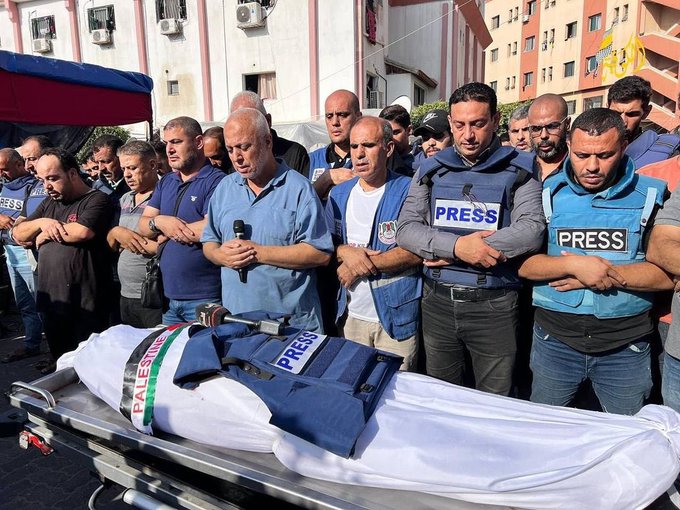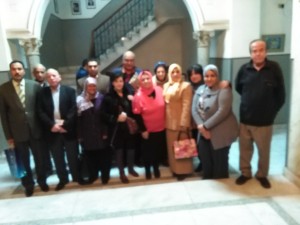In the war on Gaza Israel has deliberately made it, its objective to target and kill as many journalists as possible to frustrate the word coming out about the atrocities its committing. Although in constant denial, and more so for propaganda and public relations, killing off the messenger, has become an almost daily occurrence as Israel bombards urban areas across the Strip 24/7.
Journalists have been at the forefront of reporting and highlighting Israel’s bombing campaign and military strikes since 7th October. For that, they have paid a heavy price that continues to spiral. In just four weeks of the bloody, destructive campaign many were killed through Israeli firepower performing their duties. And the numbers are increasing by the day. Today, the Gaza media office puts the number at 48 and rising.
Mind-boggling
The mounting deaths is mind-boggling though journalists wear clearly defined helmets and vests to show they are members of the press. Everyone is flabbergasted. The Committee to Protect Journalists (CPJ) says this is the worst time for journalists since they started reporting deaths since 1992.
Up till 6 November, the CPJ reported 36 journalists were killed and included 31 Palestinians, four Israelis and one Lebanese who was working for Reuters. Eight journalists were injured, three missing and three arrested.
Nothing like this has ever happened to Palestinian journalists where killing off the messenger has become the norm – men and women reporters killed in the line of duty. The worst time for journalists was during the second Intifada in 2001 where a total of 15 people were killed. And that was at a stretch of a four-year period.
The CPJ states even the Russia-Ukraine war nothing on that scale ever happened. It added during 2022 and 2023, only 15 journalists were killed.
Harrowing
The number of deaths of journalists – across the media, including print, radio and satellite television and online websites has been harrowing. Whilst many international organizations and bodies – like International Federation of Journalists, Reporters Without Borders, Arab and Middle Eastern Journalists Association (AMEAJA), ARTICLE 19 and French media workers – are speaking against targeting journalists, the Israeli government has so far turned a deaf ear on their demand to desist.
The Israeli government has made it clear the journalists – the great majority of whom are Palestinians working for local and international networks are in a war zone to eliminate Hamas – and therefore their safety can’t be guaranteed, codewords to mean that targeting them is legitimate.
Names
Names of those journalists killed has been printed across the international media to show their murder will not be in vain. Names like Mohammad Abu Hattab for Palestine TV, and killed with his 11-member family, Majd Fadl Arandas Iyad Matar, Imad Al Wahidi, Majed Kashko, Nazmi Al Nadim, Yaser Abu Namous, Dua’ Sharaf, Saed Al Halabi, Ahmad Abu Mahdi, Sakma Mkhaimer, Mohammad, Imad Labad and Roshdi Saraj, were all killed.
They were not killed while doing their work but Israeli warplanes chose to strike their homes which means everybody that happened to be in the home or the vicinity were also killed.
But the names of those killed continued to come up in the following 30 days after 7 October, a month that seemed to be very long, bloody and destructive for everyone. Everyday there were some journalists who got killed; some may not have been reported because of the rapidity of the bloody actions on the ground.
The names of those targeted, and as provided by CPJ, continue to flick on the ticker like Mohammad Ali, Khalil Abu Aathra, Sameh Al Nady, Mahmood Balousha, Isam Bahar, Abdulhadi Habib, Yosef Maher Dawas, Salam Mema, Hussam Mubarak, Issam Abdullah, Ahmad Shehab, Mohamed Fayez Abu Matar, Saad al Taweel, Mohammad Sobh, Hisham Alnwajha and Asad Shamlakh.
Onslaught on workplaces
With the military onslaught going on – 42 percent of all housing units have been destroyed and/or damaged with whole neighborhoods being destroyed according to the UN Office for the Coordination of Humanitarian Affairs – Israeli warplanes have been targeting media offices in towers in buildings across Gaza.
The French watchdog Reporters Without Borders (RSF) reported at least 50 premises have been targeted in the course of this war. It pointed out this targeting has been “deliberate” and resulted in the “total or partial destruction of these premises.” The situation has become so dramatic the organization has called on the International Criminal Court to investigate.
After the 7 October attacks on Israeli settlements and army bases when 1400 Israelis were killed when Hamas operatives entered these areas, most western states sided with Israel. Now and four weeks latter, and with the number of Palestinians killed at over 10,000 civilians and over 25,000 injured, world opinion seems to be shifting somewhat.
Stuck in the middle
One of the reasons for the continual targeting of journalists on the ground was the fact that the Israeli military establishment sought to, literally, bomb Gaza to the ground – 30 million tons of explosives were thrown on it in the first four weeks - to the surprise of the United Nations and states including Israel’s staunch supporters like the USA, UK, France and Germany. Soon after day one, the Israeli army engaged in carpet-bombing cities, towns, camps and neighborhoods in the Gaza Strip.
Squeezing the 2.3 million population would be an understatement for Gaza is already under an Israeli-imposed siege since 2007. Instead, through bombing the northern areas of the strip, it sought to move people to the south, telling them it would be safe for them. But that proved to be a hoax.
Today around half of the bombing occurs in the center and south of the country below Gaza city, in areas like the Shiekh Radwan neighborhood, Khan Younis, Rafah and refugee camps like Al Nuseirat and Shaboura. These have become the temporary homes of many of the displaced – with up to 1.5 million – assembling there.
The Israeli logic has long been to bomb them because it claims they harbor Hamas and Izz Al Din operatives. And with that, it has continued to bomb churches, mosques, schools and UN facilities which also house most of the displaced and in hospitals. And in such situations, it does not want journalists to report that and/or keep reporting on the deteriorating state of these hospitals.
But the work of journalists has become doubly hard in the face of constant power cuts and electricity failures that are best erratic and at worst non-existent with their access to computers, internet, and communication, has ceased because of the constant bombing of infrastructure.
Thus, they can no longer power their computer, charge their mobiles or send messages. Israel is doing this to make life unbearable for them and impose a total information black out.
Families of journalists
Many of the families of journalists are being targeted as well with little or no worry about the devastating consequences. They are seen as legitimate collateral damage Israel can live with and on that score, it doesn’t seem to care too much that Hamas still holds up 250 Israelis and other foreigners.
The killing of the 11-member family of Abu Hattab was only the tip of the iceberg. Before that four members of the family of Wael Al Dahdouh of Al Jazeera television satellite were killed through an airstrike on Nuseirat Camp in the south of the Strip. Like others, they migrated to the camp for safety but in the Gaza Strip, there is no safe place.
Days before that striking which many saw as a blatant warning to Al Jazeera, US Secretary of State Anthoy Blinken urged the Qatari Prime Minister to pressure the television satellite station to tone-down its anti-Israeli sentiment during his visit to Doha.
However, the targeting of the families of journalists in Gaza continues. Like everyone else, these families are living in places where missile strikes are launched at them without any warnings.
Mohammad Abu Hasira is another late victim. His house in the Gaza fisherman’s port area was struck killing 42 members of his family including his son and brother.
Mohammad Abu Qumsan, a broadcast engineer in Al Jazeera escaped the bombing of his house because he was away working. However, through a targeted missile on his home on the Jabalia refugee camp, it killed 19 members of his family, including his father, two sisters, brother, sister-in-law and eight nephews and nieces.
Killing off the messenger will likely continue to be an Israeli policy until the objective is met to wipe out Hamas. But Hamas and Izz al Din Al Qassam operatives are nowhere to be seen, at least not among the civilian population of Gaza.




